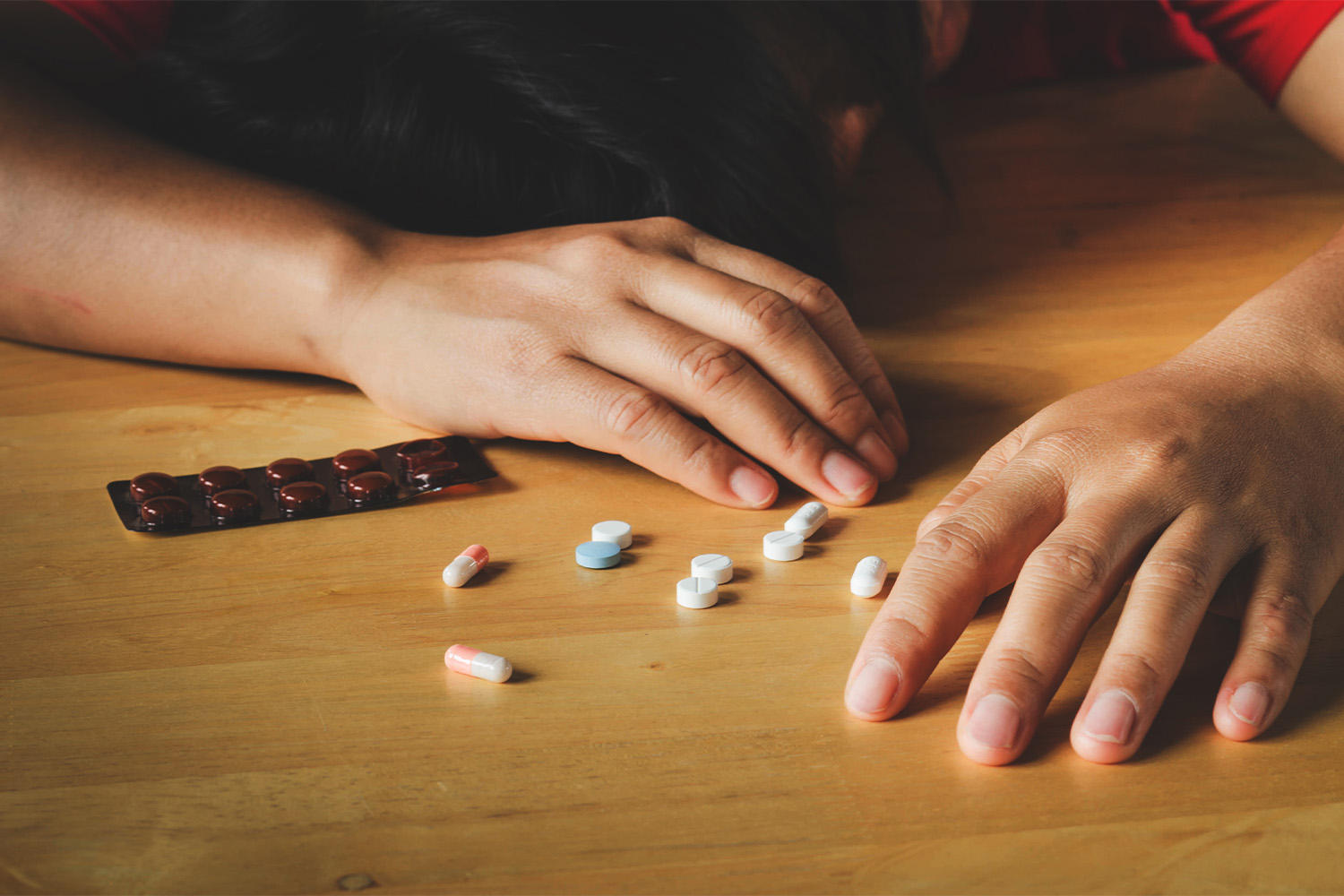In recent years, the term “Xanax” has been popularized in modern culture to a point where many people are desensitized to it. Xanax is not just a random street drug, and it’s definitely not something to laugh about.
Xanax, a benzodiazepine, is a prescription drug that helps anxiety but can sometimes be abused by the patient.
Spotting a drug addiction to Xanax can be difficult if you aren’t sure what you are looking for. Understanding the signs and learning ways to help someone struggling with a Xanax addiction could be the difference in them living a long and happy life.
What Is Xanax?
Xanax is a benzodiazepine (aka benzos) that can help people with behavioral health issues like severe anxiety disorders or panic disorders because of the calming effects it can have. The generic name for Xanax is alprazolam.
This drug is characterized as “fast-acting” and is classified as one of the most highly addictive drugs because of the brain alterations that it makes in such a short period of time.
That’s why this drug is only recommended for short periods of time — to help keep someone from experiencing a physical dependence on the drug. Even with this risk, it’s the most prescribed psychiatric drug in the United States because its effects are so impactful. With supervision and open communication, Xanax can be taken safely and does help many people overcome their everyday anxiety.
Many people who are prescribed Xanax do use it properly. This means the right amount of Xanax is taken for the right amount of time. Xanax works as expected and may never become an issue for the person. But that’s not always the case.
Some people take Xanax for the short-term yet fall into addiction quite easily, while others might have used it once or twice and began seeking it out from illegal sources.
What Are the Potential Positive Effects of Xanax?
Using Xanax produces many different effects to help support mental health, all of which aim to relax your body.
Xanax is a central nervous system depressant that helps to slow your body down. This prescription drug works by increasing the effects of a brain chemical called gamma-aminobutyric acid or GABA. GABA promotes calmness in the body by decreasing the excitement in the brain that triggers panic attacks or anxiety.
Some effects that prescribed Xanax may have are:
- Easing of muscle tension
- Help with insomnia
- Feelings of calm
- Anxiety relief
What Are Some Unintended Side Effects of Xanax?
Like with any addictive drug, there are unwanted side effects that can come from using too much of the drug for too long or, as with any drug, from taking higher doses or too much in one sitting.
Some side effects to look out for are:
- Drowsiness
- Slurred speech
- Blurry vision
- Lack of coordination
- Fatigue
- Irritability
- Nausea or vomiting
- Headaches
- Appetite changes
- Loss of interest in sex
- Dry mouth
- Difficulty concentrating
- Excessive sweating
- Constipation
- Issues with memory
- Swelling of the hands and feet
- Decline in mental health
Of course, not everyone will experience these side effects, but the more often you use Xanax can influence these reactions.
What Are the Withdrawal Symptoms of Xanax?
When someone is using Xanax, it is never a good idea to quit it cold turkey. This can be very dangerous for the user as your body has become accustomed to your benzodiazepine use. Some who quit Xanax without tapering off might be sent into shock without it.
Someone who is withdrawing from Xanax may experience:
- Insomnia and trouble staying asleep
- Sweating
- Vomiting
- Tremors
- Muscle cramps
- Stomach cramps
- Headaches
- Irritability and anger
Some even more serious withdrawal symptoms that someone might experience are:
- Delusions and delirium
- Psychosis
- Severe anxiety
If you are someone who has been prescribed Xanax, you should talk with your healthcare providers about coming up with a plan to reduce your usage instead of quitting on your own.
For those that get their Xanax illegally, you still generally not quit cold turkey. It might be more difficult to lower your dosage if you don’t have it readily available to you, so reaching out to addiction treatment centers can help you with the process.
Xanax and Sedative, Hypnotic, or Anxiolytic Use Disorder
If Xanax abuse becomes prolonged, it can eventually lead to sedative, hypnotic, or anxiolytic use disorder. In order to be diagnosed with this disorder, you need to exhibit at least 2 out of 11 of the symptoms.
These symptoms include:
- Repeated issues showing up for important events due to Xanax usage
- Using Xanax in a hazardous setting
- Wanting to stop using it but being unable to
- Using Xanax even though it brings you distress and frustration
- Spending a lot of time trying to obtain Xanax
- Using Xanax for longer than prescribed or needed
- Using despite one or more negative personal outcomes
- Craving Xanax
- Experiencing withdrawal symptoms
- Stopping participation in work, family, or social events
- Building up a tolerance to Xanax so that you need more to feel the effects
These symptoms need to co-occur within a 12-month period for someone to be diagnosed with this disorder. It’s still classified as a substance use disorder. Fortunately, there is Xanax addiction treatment.
How To Recognize a Xanax Problem
Trying to recognize Xanax addiction is not always easy, as is with any substance abuse issue. If you don’t know what to look out for, you may never see the signs. If you are aware that someone you know is being prescribed Xanax, and you know they have addictive tendencies, don’t be afraid to reach out to see how they are doing.
As helpful as Xanax may be for mental wellness, it can become a slippery slope into addiction for some people.
Xanax is commonly prescribed to people. It’s typically easy to get, which makes it that much easier for it to potentially cause a problem.
College-age students are at higher risk of coming into possession of Xanax without having a prescription. Some people might think that it is a “fun” drug to use and mix with other substances, but it can be deadly to combine Xanax with other drugs like opioids and alcohol.
Signs of Xanax Abuse
There are different ways for you to recognize whether or not someone is struggling with Xanax addiction. No two people will present their symptoms or issues in the same way, but Xanax has certain effects that might be prevalent.
If you think that someone you love is struggling with an addiction to Xanax, consider reaching out to representatives at Soba Recovery Center to voice your concerns and come up with a plan for treatment.
Find others who love and support this person and try to have a safe and open conversation about your concerns and their wellbeing. Choose friends or family who can contribute to a judgment-free zone to better encourage someone with a benzodiazepine addiction to seek help.
Withdrawn From Family and Friends
Someone who is struggling with Xanax addiction might find that they are avoiding facing their friends and family. They might begin to feel intense shame or guilt over their usage and don’t want to face their loved ones.
Sometimes facing people who know you best is difficult because they know what to look out for. It’s harder to pretend everything is okay. A person who is addicted to Xanax may become defensive about their addiction. Loved ones without the right tools or resources in place may unknowingly create more tension.
Needing More Xanax To Feel the Effects
As someone becomes more dependent on Xanax, their tolerance will go up. If you notice that someone is using more Xanax than they are prescribed or using it every day without a prescription, they may have a problem.
A person’s body adapts to Xanax. Over time, someone might find that they need more Xanax to feel the same way. This pattern can lead to an addiction.
If you or someone you love begins to take more Xanax without medical supervision, it could lead to an addiction. Tolerance is one of the easiest ways to determine whether or not someone has an addiction to Xanax.
Experiencing Financial Issues
Someone who is struggling with Xanax might need more Xanax than they are prescribed, which could lead to illegal sourcing. This can be dangerous for many reasons. Many Xanax pills that are bought off the street aren’t actual Xanax pills, which could lead to a dangerous situation. Additionally, it can be quite expensive to keep up with a Xanax addiction.
A loved one might ask you for money or show signs of financial distress when using Xanax improperly. It’s important to pick up on these subtle signs to determine whether or not someone is in need of addiction treatment.
Having Erratic Emotions
A sign of Xanax abuse is emotional instability. A person who has a Xanax addiction might have intense mood swings, become easily irritable, and sometimes become aggressive. Someone who is using Xanax may be emotionally unpredictable, which can be alarming.
You may feel like you’re walking on eggshells around them, trying to anticipate their next mood swing.
Someone struggling with their addiction might also experience severe depression and suicidal thoughts, especially if they are trying to cut back on their usage and stop altogether. The process is not easy, and it can feel isolating. Showing support to your loved ones who are struggling can help encourage them to seek treatment.
Getting Help with Soba Recovery
Xanax addiction is not something people can typically overcome on their own. They need a safe place to detox, find support, and get the right addiction treatment.
At Soba Recovery Centers in San Antonio, Texas, you’ll receive professional addiction treatment geared specifically to your personal needs.
If you are struggling with Xanax withdrawal symptoms, you can enter into a detoxification treatment that will safely allow you to come off of the drug. Afterward, there are both inpatient and outpatient services available, depending on your treatment needs.
Whether you are looking for sober living in a supportive community atmosphere or need intense treatment that allows more freedom like partial hospitalization, we have got you covered.
Addiction is not a choice. It’s scary, difficult, and debilitating. Get back to feeling like yourself again. If you or a loved one need assistance overcoming Xanax addiction, reach out today and learn more about what Soba has to offer.
Sources:
Alprazolam (Xanax) | NAMI: National Alliance on Mental Illness
A Review of Alprazolam Use, Misuse, and Withdrawal | NCBI
Sedative, Hypnotic or Anxiolytic Drug Use Disorder | Harvard Health



